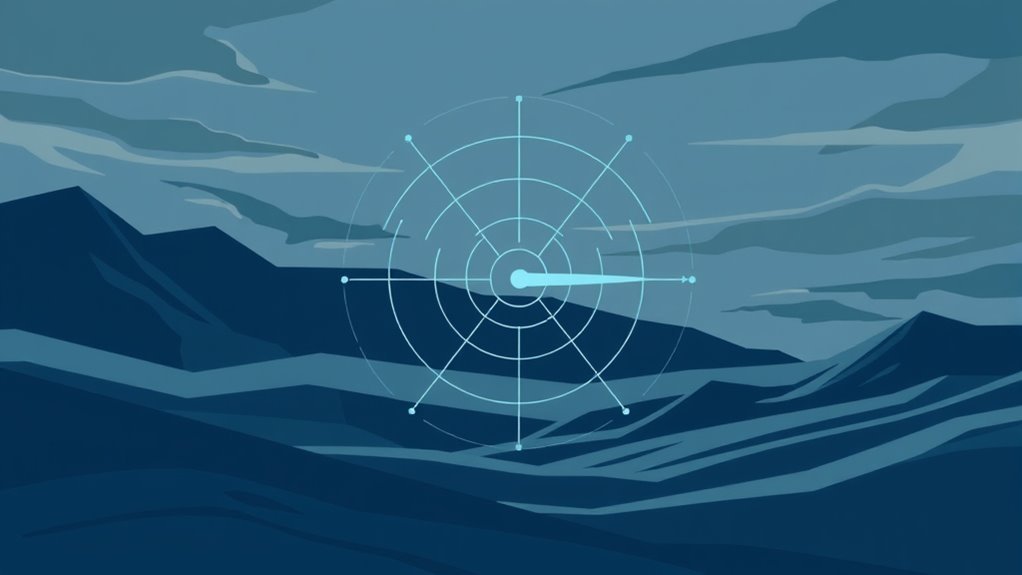Squall data visualization is essential for meteorological analysis as it simplifies complex weather data. By transforming raw data into intuitive visual formats, it aids understanding and improves decision-making. Techniques like color-coded maps and vector mapping boost the recognition of squall patterns. Real-time monitoring and predictive accuracy benefit from these visual tools, promoting public safety during severe weather events. Exploring further will highlight more about the advancements and applications in this important area of meteorology.
Main Points
- Squall data visualization simplifies complex weather data, making it easier to recognize patterns and trends for meteorologists and the public.
- Effective visual representations enhance real-time monitoring, allowing for timely responses during severe weather events like squalls.
- Visualizations improve communication of meteorological concepts, increasing public awareness and understanding of squall impacts.
- Integrating multiple data sources through visualization techniques enhances predictive accuracy and reduces errors in data interpretation.
- Advanced visualization tools support informed decision-making, ultimately contributing to improved public safety during extreme weather conditions.
Understanding Squalls and Their Impact on Weather
Squalls, defined by sudden and intense bursts of wind and precipitation, play an essential role in meteorological phenomena. These unpredictable weather events can occur in various forms, including rain, snow, or thunderstorms, and often lead to rapid changes in temperature and visibility.
Their formation is typically associated with cold fronts, where warm air is abruptly lifted, resulting in turbulent conditions. Squalls can cause substantial disruptions, particularly for maritime and aviation operations, due to the sudden onset of strong winds and reduced visibility.
The intensity and duration of squalls vary, influencing their potential impact on local ecosystems and human activities. Understanding these phenomena is vital for accurate weather forecasting and risk management, as they can lead to hazardous situations.
The Role of Data Visualization in Meteorology

Data visualization serves as an essential tool in meteorology, enabling scientists and forecasters to interpret complicated weather data effectively. Through graphical representations, meteorologists can quickly recognize patterns and trends that might remain obscured in raw numerical data.
Visual tools, such as charts, maps, and animations, simplify the communication of elaborate weather phenomena, making it easier for both experts and the general public to understand potential weather events.
Moreover, data visualization improves decision-making processes during severe weather events, allowing for timely warnings and informed responses. This capability is particularly vital in tracking squalls, where rapid changes can pose major threats.
Key Techniques in Squall Data Visualization
Key techniques in squall data visualization include visualizing squall patterns, analyzing wind speeds, and mapping precipitation trends.
These methods provide critical observations into the dynamics of squalls, enhancing meteorological analysis.
Visualizing Squall Patterns
Although squall patterns can be complex, effective visualization techniques can greatly augment meteorological analysis.
Utilizing color-coded maps allows meteorologists to identify regions of intensity and track squall movements. Time-lapse animations illustrate how squalls evolve over time, providing perspectives into their development and dissipation.
Additionally, contour plots can depict temperature and pressure gradients, highlighting conditions conducive to squall formation. Three-dimensional visualizations further improve understanding by representing the vertical structure of these phenomena.
Integrating radar data with satellite imagery enables a thorough view, capturing both precipitation and cloud dynamics.
These visualization methods not only promote immediate assessment but also support long-term studies, aiding in predictive modeling and improving safety measures during severe weather events.
Analyzing Wind Speeds
Wind speed analysis plays an essential role in understanding squalls and their impact on weather systems. By examining wind speed data, meteorologists can identify patterns and predict squall intensity and duration.
Various techniques improve the visualization of wind speeds within squall events, allowing for clearer observations.
Key techniques include:
- Time-Series Analysis: Tracking wind speed changes over time to identify trends.
- Vector Mapping: Depicting wind direction and magnitude visually through arrows.
- Heat Maps: Highlighting areas of varying wind intensity across regions.
- Statistical Modeling: Employing statistical methods to forecast potential squall occurrences.
- Real-Time Data Integration: Utilizing live data feeds for immediate analysis and response.
These techniques contribute greatly to advancing squall forecasting and safety measures.
Mapping Precipitation Trends
Mapping precipitation trends is essential for understanding the behavior of squalls and their potential impacts on the environment.
Utilizing advanced visualization techniques, meteorologists can effectively display historical and current precipitation data, revealing patterns associated with squall events. Geographic Information Systems (GIS) play an important role in this process, allowing for the layering of precipitation data over topographic and urban maps, which helps identify vulnerable areas.
Time-series analysis further improves comprehension by illustrating changes in precipitation intensity and frequency over time. Additionally, interactive visualizations enable users to examine data dynamically, promoting a deeper insight into squall-related precipitation trends.
In the end, these mapping techniques are essential for informed decision-making in weather forecasting and disaster preparedness.
Enhancing Predictive Accuracy With Visual Data

As meteorologists increasingly turn to advanced data visualization techniques, the potential for enhancing predictive accuracy becomes evident. By transforming complex datasets into intuitive visual formats, meteorologists can better interpret patterns and anomalies that may otherwise go unnoticed. This approach allows for more informed decision-making and improved forecasting.
Key benefits of visual data in meteorological analysis include:
- Clear Pattern Recognition: Visualizations help identify trends and correlations quickly.
- Enhanced Communication: Visual data allows for simpler explanations of complex meteorological concepts to the public.
- Real-Time Monitoring: Dynamic visualizations provide up-to-date observations for timely responses.
- Error Reduction: Visual aids minimize the risk of misinterpretation of raw data.
- Interactive Investigation: Users can manipulate visual data to examine various scenarios and outcomes.
Ultimately, these advancements lead to more accurate weather predictions, greatly benefiting disaster preparedness and response efforts.
Case Studies: Successful Applications of Squall Data Visualization

Recent advancements in squall data visualization have led to noteworthy improvements in meteorological analysis. One case study involved a regional weather service that implemented squall data visualization techniques to track severe thunderstorm formations. By utilizing high-resolution visualizations, meteorologists were able to identify squall lines earlier, allowing for timely warnings that considerably reduced risk to the public.
Another successful application occurred in agricultural management, where farmers employed squall data visualizations to optimize irrigation schedules. By analyzing storm patterns, they could anticipate rainfall, leading to more efficient water usage and improved crop yields.
In a third instance, a research team utilized squall visualization methods to study the dynamics of winter storms. Their findings contributed to a better understanding of snow squalls, in the end improving forecasting accuracy, which is critical for travel safety in affected regions.
These case studies illustrate the transformative impact of squall data visualization across various sectors.
Tools and Technologies Used in Squall Data Visualization
In the domain of squall data visualization, various tools and technologies play an essential role in enhancing meteorological analysis.
Key components include data collection techniques that gather relevant atmospheric information, visualization software tools that transform complex data into understandable formats, and real-time analysis methods that enable timely decision-making.
Together, these elements promote a thorough understanding of squall dynamics and their consequences.
Data Collection Techniques
Data collection techniques play an essential role in squall data visualization, enabling meteorologists to analyze and interpret complex weather phenomena effectively.
These techniques guarantee the accurate gathering of atmospheric data critical for understanding squall dynamics. Various methods are employed to capture detailed information, which includes:
- Remote Sensing: Utilizing radar and satellite imagery to monitor weather patterns.
- Weather Stations: Collecting real-time data on temperature, humidity, and wind speed.
- Doppler Radar: Analyzing precipitation and storm structure through advanced radar technology.
- Buoys and Ocean Sensors: Measuring sea surface conditions that influence squall formation.
- Aircraft Reports: Gathering in-flight data that provides perspectives into upper-atmosphere conditions.
Implementing these techniques improves the accuracy of squall visualizations and supports informed decision-making in meteorology.
Visualization Software Tools
Effective squall data visualization relies heavily on a range of sophisticated software tools that elevate the analysis and presentation of meteorological data.
These tools include Geographic Information System (GIS) software, which allows users to map and analyze spatial data effectively. In addition, data visualization platforms such as Tableau and Power BI offer intuitive interfaces for creating dynamic visual representations of complex datasets.
Meteorological modeling software, like WRF and GFS, provides essential simulations that can be visualized to predict squall behavior. Moreover, programming languages like Python and R, equipped with libraries for data manipulation and visualization, enable custom analyses tailored to specific research needs.
Collectively, these technologies elevate understanding and communication of squall phenomena among meteorologists and stakeholders.
Real-time Analysis Methods
While traditional methods of meteorological analysis have their merits, real-time analysis methods are essential for understanding squall events as they unfold. These approaches utilize advanced technologies to provide timely data vital for accurate forecasting and safety measures.
Key tools and technologies include:
- Automated Weather Stations: Collect live data from various locations.
- Doppler Radar: Detects precipitation intensity and wind patterns in real-time.
- Satellite Imagery: Offers a broad view of weather systems and cloud formations.
- Data Fusion Techniques: Integrate multiple data sources for thorough analysis.
- Machine Learning Algorithms: Improve predictive capabilities through pattern recognition.
Utilizing these real-time methods greatly enhances the ability to respond to squall events, thereby minimizing risks and improving public safety.
Future Trends in Meteorological Data Visualization
How will advancements in technology reshape the terrain of meteorological data visualization? Emerging technologies such as artificial intelligence, machine learning, and augmented reality are poised to revolutionize how meteorological data is presented and interpreted.
AI algorithms will improve predictive capabilities, enabling more accurate forecasts and timely alerts. Machine learning will ease the analysis of extensive datasets, identifying patterns that may not be apparent through traditional methods.
Furthermore, augmented reality tools will allow users to interact with weather data in immersive environments, nurturing a deeper understanding of meteorological phenomena. The integration of real-time data streaming will boost situational awareness, providing immediate revelations during severe weather events.
As visualization techniques evolve, they will become increasingly user-friendly, allowing non-experts to grasp complex meteorological information easily. In the end, these advancements will deepen public engagement with weather data, improving individual preparedness and community resilience against climate-related challenges.
Common Questions
How Does Squall Data Visualization Differ From Other Weather Data Visualization Methods?
Squall data visualization uniquely emphasizes rapid atmospheric changes, showcasing real-time data through dynamic graphics. Unlike traditional methods, it integrates advanced algorithms to highlight transient weather phenomena, enhancing interpretability and decision-making for meteorologists and researchers.
What Are Common Challenges Faced in Squall Data Visualization?
Common challenges in squall data visualization include data integration from diverse sources, managing high-resolution spatial and temporal data, ensuring clarity in representation, and addressing the dynamic nature of squall events that complicates accurate forecasting and analysis.
Which Meteorological Organizations Lead in Squall Data Visualization Research?
Meteorological organizations such as the National Oceanic and Atmospheric Administration (NOAA), the European Centre for Medium-Range Weather Forecasts (ECMWF), and various academic institutions are at the forefront of squall data visualization research, advancing analysis techniques and methodologies.
How Can Squall Data Visualization Improve Public Safety During Severe Weather?
Squall data visualization improves public safety by providing clear, real-time information about severe weather patterns. This allows communities to prepare and respond effectively, reducing risks associated with sudden weather changes and improving comprehensive emergency management strategies.
What Training Is Required for Meteorologists to Effectively Use Squall Data Visualization Tools?
Meteorologists require training in data analysis, software proficiency, and visualization techniques to effectively utilize squall data visualization tools. This training improves their ability to interpret complex weather patterns and communicate findings clearly to the public.

